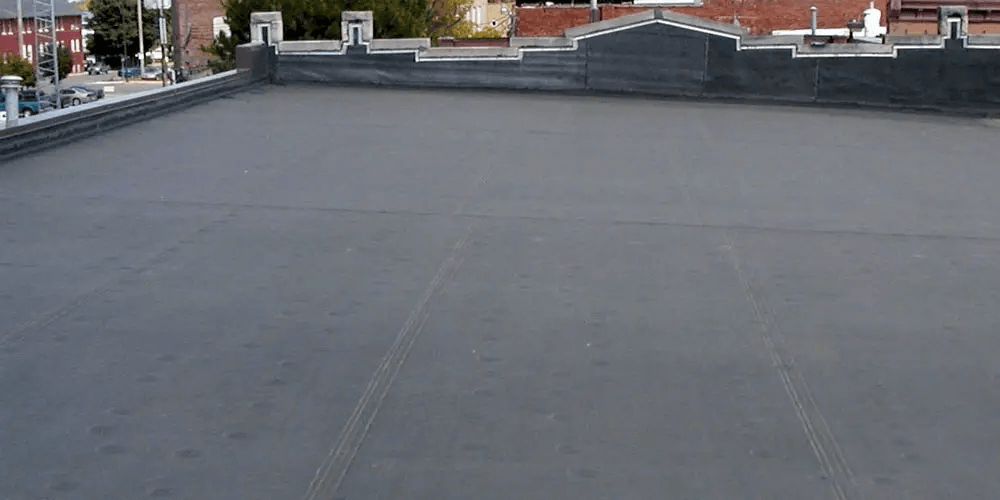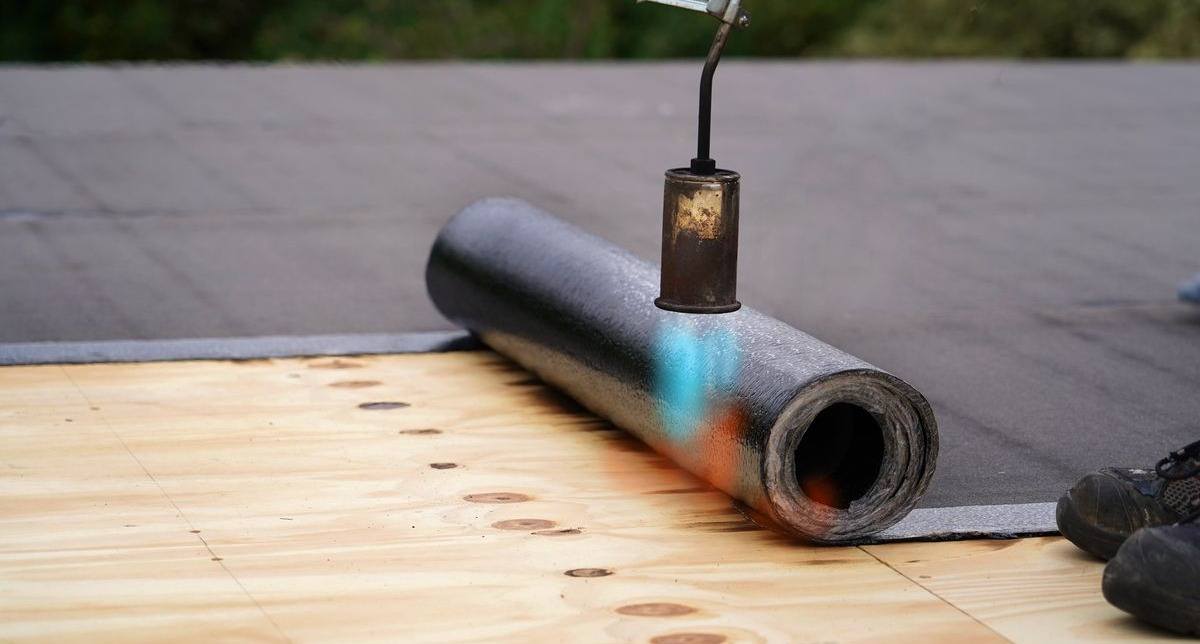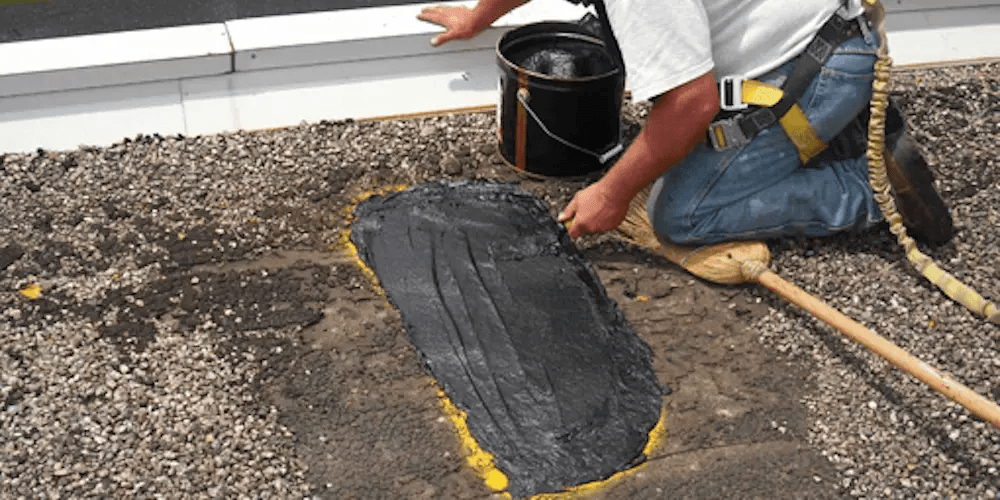If you have a flat or low-slope roof, you're probably familiar with EPDM or TPO rubber. While these materials may be weatherproof and can last up to 50 years, they can also stretch and degrade over time, causing leaks. EPDM is among the most common flat roof options for residential and commercial roofing, and it is possible to fix yourself. But if your roof has TPO or another rubber material like PVC or modified butamin, we recommend hiring a professional to repair the roof. In this article, we'll discuss what to look for, common mistakes to avoid, and how to repair your flat roof if you're able to do it yourself.
What to look for
If your flat roof is leaking, don’t panic. While it’s important not to prolong the issue, there are several things you should look for before you make any decision about whether to fix it yourself or hire a professional roofer.
Material

Image source: A-Denver Roofing
First, it's important to identify which material your flat roof has. Each type of rubber roofing material is going to have different requirements for repairs. The most common types include EPDM (ethylene propylene diene monomer rubber), TPO (thermoplastic polyolefin), PVC (polyvinyl chloride), BUR (built-up roof), and modified bitumen. Roof materials like BUR and modified bitumen are typically more common on commercial buildings.
For homeowners with EPDM, TPO, or PVC: while all three of these types have a single-ply roof membrane of rubber, each material has different characteristics. EPDM comes in black seamless rolls, which are easy to install and can be done yourself. PVC and TPO require professional roof installation with a specialized hot air gun and typically have a white top layer. While PVC remains a popular option, it has been known to pose health risks by emitting toxic pollutants and chemicals.
Source of the leak

If you just encountered a big storm the night before and see water spots or stains on the ceiling, you probably have a roof leak. But finding the source of the leak may not be as easy as it seems and may not be exactly where the water seeps through. After checking for any tears or holes in the rubber, check the entry point of the roof. Most flat roofs feature a small slope which allows for water runoff, and many leaks can be found within ten feet of the entrance point. Another possible source could be around the vents, skylights, or flashing where the sealant could be dry and cracked. If you can't find any obvious damage, you should hire a professional roofing company to inspect the roof.
Roof deck condition

Image source: PGRS
If you have a leak, it's important to check the status of your roof deck to determine if it's structurally sound. Check the decking for any soft spots or signs of moisture. Water leaks can lead to wood rot or mold, weakening the structural integrity of the roof decking or beams. In severe cases, standing water and active leaks can lead to decking failure and devastating consequences.
Vent pipes

Image source: Doityourself
No matter what kind of roof vents you may have, make sure to check the pipe boot, flashings, caulk, or any rubber sealant around the pipes. These types of sealants can become brittle and crack over time from severe weather.
Shrinkage

Image source: Commercial Roof USA
Although EPDM reflects solar heat, it can degrade and shrink over time from UV rays and severe storms. Even if you don't have a leak, it's important to check the durability of your roof's material for any kind of shrinkage. One of EPDM's other drawbacks is its fragility to impact which can puncture through the membrane. Any kind of damage to the membrane can lead to leaks. While most EPDM roofs feature a strong puncture warranty, it's still an issue to keep in mind for your new roof.
What to avoid

Image source: Bluedrop Services
Once you’ve identified the source of the leak and decided to repair it, let’s make sure this doesn’t happen again. Here are several key points to remember for maintaining your flat roof and avoiding any kind of future damage.
Missing ventilation

Ventilation is necessary for flat roof systems to avoid excess heat and moisture from building up. While it does make a difference if you have a warm roof that's insulated, installing a pop-up vent and ventilator will prevent moisture and mold growth.
Snow and ice removal

Image source: LaFerney
Keeping your flat roof free of any debris, snow or ice is essential in preventing damage. Not only do snow and ice dams cause excess water damage and moisture, but they also add unnecessary weight and strain to your roof.
Patching

Image source: RenoCompare
While patching can be a DIY short-term solution for minor leaks, it doesn’t completely fix the problem. If you do decide to patch up your roof leak, make sure you routinely check on it and follow it up with a more thorough repair.
Ponding

Image source: Infinite Roofing
If low-sloped roofs don't have any proper drainage like gutters or interior drains, standing water can accumulate, otherwise known as ponding. Make sure your draining system is large enough for your roof, and for larger roofs, consider installing internal drains.
Wrong roof coating

Image source: Progressive Materials
If you live in a wet climate, applying a coating to your flat roof is essential. Spray coating your roof can help eliminate ponding and increase the lifespan of your flat roof's material. But if you apply it too thinly or thickly, it won't last as long. Applying a coating in cold temperatures or before a rainstorm can reduce its effectiveness. It's recommended that you recoat your roof every two-to-four years to ensure that your flat roof lasts for years to come.
DIY vs. contractor

Once you’ve found the source of your leak, it’s important to know if you’re able to do the job yourself or if you should hire a professional.
DIY
If you have an EPDM rubber roof, patching kits work for minor repairs and only offer a temporary fix. If it's something as simple as re-caulking or resealing certain areas around the vents, you should also be able to do it yourself as long as you minimize foot traffic. Unlike roofing systems with shingles, flat roofs aren't designed to withstand heavy weight and the material can split or blister.
Contractor
If your flat roof has another material like TPO or PVC, you're going to have to hire a professional contractor. These rubber materials are not only toxic, but they are welded using a hot air gun, requiring professional repair. The last thing you want to do is shorten your roof's lifespan and have to pay for a full replacement. Flat roof replacement costs can total thousands of dollars.
How to repair a flat roof

Image source: Tufano and Sons
If you have an EPDM rubber roof and you’ve decided to make minor repairs yourself, here are two methods to consider. In order to maintain the longevity and durability of your roof, you should recoat your flat roof at least once every two-to-four years. For minor cracks and leaks, using a patch can also be a successful temporary solution. Remember, for most flat roof repairs, it’s wise to call in a professional contractor with the necessary tools and experience to avoid any further damage.
Resealing the roof
- Dry the surface - The first thing you need to do is make sure your roof is dry, so avoid any risk of incoming storms and scrape away any moss, dirt, or debris. Use a broom to sweep off any excess waste from the roof.
- Use a primer - Next, you’ll want to use a coat of bitumen primer with a roller. Pour a small amount of the primer onto the roof and spread it evenly to all corners. Use as little primer as possible to avoid any excess liquid or unevenness. Depending on the temperature outside, you’ll need to let the primer dry up to a couple of hours.
- Use a sealant - After your bitumen primer has dried, it’s time to coat it with a waterproofing sealant. When opening the can of sealant, make sure you stir it up like a can of paint. Next, use a hard-bristle brush and spread the sealant over the top of the primer, which should easily bond together. Once you’ve coated the entire roof with the sealant, it should become waterproof within hours. We also recommend adding a second coat after 12 hours.
- Consider a solar reflective coating - Although it is optional, consider adding a solar reflective coating that can be applied the same way as the primer.
Patching the roof
- Clean the area - First, you'll want to clean the surface area with a household all-purpose cleaner. Use a rag to dry off any excess moisture and keep the patching area as dry as possible.
- Cut patch - Then make sure you cut the patch to the size you need. Keep in mind that your patch should extend two inches on all sides past the patching area. Using a pair of scissors or utility knife, cut off the sharp corners to avoid any kind of lift.
- Use a primer - Next, you'll want to use an adhesive primer and lightly brush it over the patch area. Again, make sure to extend the primer past where the patch will go.
- Apply the patch - Now it's time to firmly press the patch into place and use a roller to bond the patch.
- Use a lap sealant - Once you've firmly pressed your patch in, it's time to use an EPDM lap sealant along the edges of the patch area. Smooth and flatten out the sealant and your patch should then have fully adhered.
In summary
Having a leak in your home can be an absolute nightmare. Depending on how bad the leak or crack in your flat roof is, there are a variety of repair options. For minor fixes, it is possible to temporarily patch up areas and reseal your roof every year or two. But the best thing you can do is remember that flat roofing requires routine maintenance. Make sure your roof is usually dry, clean off any debris or branches, make sure you have proper ventilation, or at least have gutters for water to runoff. Properly maintaining your flat roof should avoid the risk of any leaks, but rubber materials also degrade over time. Potentially, rubber materials have the ability to last up to 40 or 50 years. The key thing to remember is to keep your flat roof in good shape, and always consider hiring a roofing contractor to inspect the leak for you.
Chris Gennone is a content specialist and video producer at Fixr.com. He has 5 years of experience writing and editing for a variety of web and print publications, currently specializing in home improvement projects such as roofing, remodeling, and repairs. When Chris isn’t writing or in front of the camera, he’s either playing with his band or tracking down the best sandwich shops.
